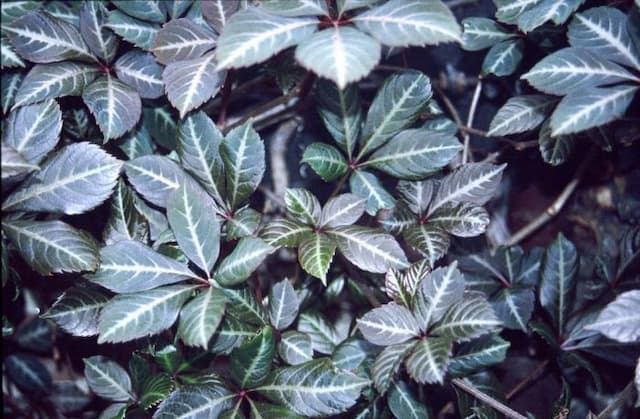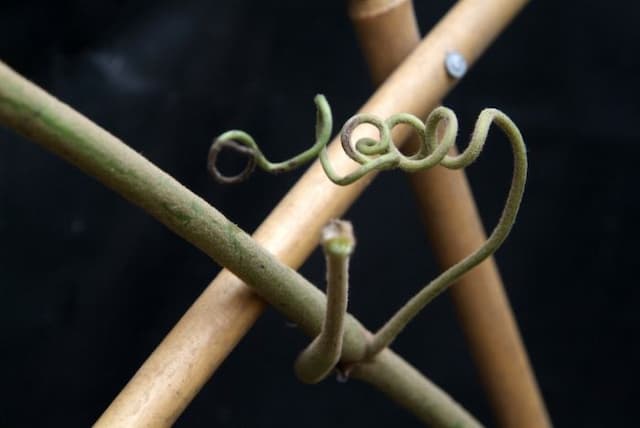Crimson glory vine Vitis coignetiae

ABOUT
V. coignetiae is a very strong-growing, large deciduous tendril-climber with slightly lobed, broad-ovate leaves to 30cm in length, turning scarlet and crimson in autumn. Insignificant flowers and small, black berries
About this plant
 Names
NamesSynonyms
Crimson Glory Vine, Glorie Vine, Coignet Grape.
Common names
Vitis coignetiae_PULLA, Vitis amurensis_var._coignetiae
 Characteristics
CharacteristicsLife cycle
Perennials
Foliage type
Deciduous
Color of leaves
Green
Flower color
Greenish-white
Height
30 98 (9 30)
Spread
10 3 (3 1)
Plant type
Climber
Hardiness zones
5
Native area
Japan Korea
Benefits
 General Benefits
General Benefits- Aesthetic Appeal: The plant, commonly known as Crimson Glory Vine, is admired for its large, heart-shaped leaves that provide a lush, vibrant green backdrop during the growing season.
- Seasonal Interest: It exhibits stunning autumn colors, with leaves turning vivid shades of red and purple, enhancing the visual appeal of gardens in the fall.
- Shade Provision: With its broad foliage and dense growth habit, Crimson Glory Vine can create natural shaded areas, ideal for outdoor relaxation spots or to reduce sunlight on building exteriors.
- Privacy Screen: Due to its vigorous growth, it can quickly form a dense cover, serving as an effective privacy screen or natural barrier in landscapes.
- Erosion Control: The robust root system of Crimson Glory Vine can help stabilize soil, reducing erosion on slopes and banks.
- Wildlife Support: The vine provides habitat and food for various species of birds and insects, contributing to the local ecosystem's biodiversity.
- Architectural Integration: It can be trained on structures such as pergolas, arbors, and walls, blending built environments with natural greenery.
- Cultural Significance: In some regions, the plant is valued for its ornamental qualities and is used in traditional gardening and landscape design.
 Medical Properties
Medical Properties- This plant is not used for medical purposes.
 Air-purifying Qualities
Air-purifying QualitiesThis plant is not specifically known for air purifying qualities.
 Other Uses
Other Uses- Vitis coignetiae, commonly known as Crimson Glory Vine, can be used in large-scale landscaping to create dramatic backdrops with its lush foliage and bright fall colors.
- The substantial leaves of the Crimson Glory Vine are sometimes used in floral arrangements or as natural decorative elements in crafts due to their size and texture.
- In gardening, the plant is utilized for training over pergolas or arbors to create shaded walkways or sitting areas, capitalizing on its vigorous growth habit.
- Crimson Glory Vine is occasionally planted for erosion control on slopes or banks due to its dense root system, which helps stabilize the soil.
- The vine's ability to grow on various structures like fences makes it a natural choice for privacy screening in residential gardens.
- During the fall, the vivid foliage of the Crimson Glory Vine can be a food source for several insects and invertebrates, contributing to the ecosystem's biodiversity.
- The robust and extensive vine growth can be used as a support structure for other climbing plants, such as certain types of roses, allowing for multi-layered vertical gardening.
- Its dense foliage can provide a cool microclimate during hot summer months, making it a strategic plant to grow in urban gardens to mitigate heat.
- When planted in large containers, Crimson Glory Vine can be used on balconies or patios to create green screens for privacy and aesthetic appeal.
- Gardeners might use the Crimson Glory Vine's thick growth as a natural barrier to discourage unwanted foot traffic through certain areas of a garden or property.
Interesting Facts
 Feng Shui
Feng ShuiThe Crimson Glory Vine is not used in Feng Shui practice.
 Zodiac Sign Compitability
Zodiac Sign CompitabilityThe Crimson Glory Vine is not used in astrology practice.
 Plant Symbolism
Plant Symbolism- Abundance: Vitis coignetiae, commonly known as the Crimson Glory Vine, produces grapes and lush foliage, symbolizing abundance and plenty.
- Vitality: The vigorous growth of the Crimson Glory Vine represents strong life force and energy.
- Transformation: As the leaves of this vine change color dramatically with the seasons, it symbolizes change and transformation.
- Connection: The tendrils of the vine and its climbing nature signify connection and interdependence, reflecting the human need for social ties.
- Fertility: This plant's ability to bear fruit is often taken as a symbol of fertility and creativity.
 Water
WaterCrimson Glory Vine needs regular watering during its growing season, typically once a week. The soil should be kept moist but not waterlogged, with thorough watering to encourage deep root growth. It's important to avoid overhead watering to prevent fungal diseases. An adult plant usually requires about 1 to 1.5 gallons of water. During winter, reduce watering frequency to when the soil is dry to the touch, as the plant is dormant and requires less water.
 Light
LightCrimson Glory Vine thrives best in full sun to partial shade. It should be placed in a spot where it can receive at least 6 hours of sunlight each day. While it can tolerate some shade, the vine may produce less vigorous growth and fewer flowers in too much shade.
 Temperature
TemperatureCrimson Glory Vine is hardy and can tolerate a temperature range from around 20°F to 85°F. The ideal growing conditions for this vine would include temperatures consistently between 60°F and 80°F. It is important to protect the vine from frost, which can damage new growth.
 Pruning
PruningPruning is essential for the Crimson Glory Vine to maintain its shape, encourage new growth, and to remove any dead or diseased wood. The best time to prune is in late winter or early spring before new growth starts. It's generally pruned annually, but light pruning can be done throughout the growing season as necessary.
 Cleaning
CleaningAs needed
 Soil
SoilCrimson Glory Vine prefers a well-draining soil mix with a pH between 5.5 and 7. An ideal mixture would be one part garden loam, one part peat moss, and one part sharp sand to facilitate proper drainage and aeration. Mulching with organic matter can help maintain soil health.
 Repotting
RepottingCrimson Glory Vine, being a vigorous and large-growing vine, doesn't require frequent repotting once planted in the ground. When grown in containers, young plants may be repotted every 2 to 3 years to encourage growth.
 Humidity & Misting
Humidity & MistingCrimson Glory Vine is adaptable to a wide range of humidity levels but thrives best in moderate to high humidity. It is tolerant to the varying humidity levels typically found outdoors in its growing zones.
 Suitable locations
Suitable locationsIndoor
Grow Crimson Glory Vine in a large, sturdy pot with ample support for climbing.
Outdoor
Plant Crimson Glory Vine in fertile soil, full sun to partial shade, and provide sturdy support.
Hardiness zone
5-9 USDA
 Life cycle
Life cycleVitis coignetiae, commonly known as Crimson Glory Vine, begins its life as a seed, entering the germination stage with increasing temperature and moisture in the spring. Once germinated, the seedling emerges and develops into a young vine, which undergoes vegetative growth, establishing a robust root system and climbing stems. As the plant matures, it enters the flowering stage, typically in the summer, where small greenish flowers are produced, often unnoticed due to their size and color. Following pollination, these flowers develop into clusters of grapes, which, while not highly regarded for consumption, complete the reproductive cycle. The vine then enters a period of dormancy in the winter, where it loses its leaves and conserves energy. With the return of spring, the vine exits dormancy, resumes vegetative growth, and the cycle repeats, with the plant capable of living and producing for several decades under optimal conditions.
 Propogation
PropogationPropogation time
Spring-early summer
Vitis coignetiae, commonly known as Crimson Glory Vine, is typically propagated in late winter or early spring before the new growth begins. The most popular method is through hardwood cuttings, which are taken from mature, well-ripened wood from the previous season’s growth. Cuttings should be about 6 to 8 inches (15 to 20 cm) long, with several buds per cutting. These cuttings can be stuck in a mixture of sand and peat or in a propagating medium with good drainage and kept moist until roots develop. Rooting hormone can be applied to the cut end to encourage root growth. The cuttings are usually ready to be potted or planted out once the roots are a few inches long, which might take several weeks to a few months.









